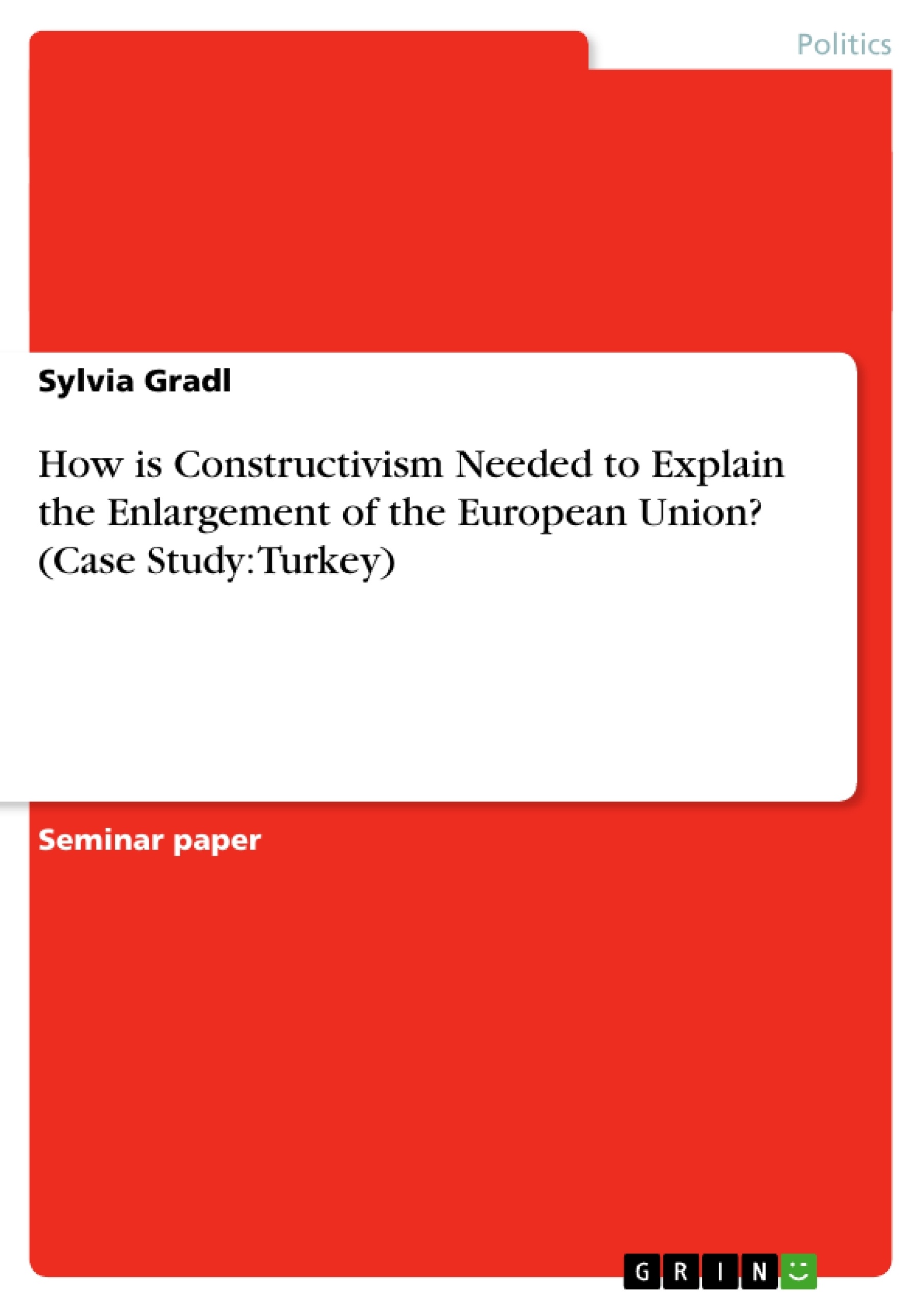This year the first new member states of the Eastern enlargement will join the EU. This refreshes also the debate about Turkey’s potential entry. No country has such a long time of appliance like Turkey and still there is the discussion if Turkey should join the EU at all. In the following I will explain why rational or constructivist reasons alone are not enough for explaining Turkey’s situation. I will try to show how the theory of Frank Schimmelfennig is needed to explain the enlargement of the EU. For this, Turkey will be my case study. First a general description of Schimmelfennig´s idea will introduce my case study before I will adapt his theory to the integration process of Turkey. Frank Schimmelfennig bases his theory on rationalism and constructivism. For him the enlargement of the EU cannot only be explained by rational arguments about costs, benefits and state preferences. But also pure constructivism has some gaps in explaining why the EU wants to have new members or why new members want to join the EU. [...]
Inhaltsverzeichnis (Table of Contents)
- Introduction
- Schimmelfennig's Theory of Rhetorical Action
- State Preferences and Enlargement
- Constructivism and the Logic of Appropriateness
- The European Union's Enlargement Criteria
- Turkey's Integration Process
- Historical Context
- Obstacles to Turkey's Integration
- The Role of "Drivers" and "Brakemen"
- Conclusion
Zielsetzung und Themenschwerpunkte (Objectives and Key Themes)
The main objective of this work is to analyze the European Union's enlargement process, specifically focusing on Turkey's case, through the lens of Frank Schimmelfennig's theory of rhetorical action. The author aims to demonstrate how this theory, which combines elements of rationalism and constructivism, provides a more comprehensive explanation of the integration process compared to solely relying on rational or constructivist arguments.
- The role of "rhetorical action" in EU enlargement
- The influence of state preferences and the "driver" and "brakeman" model
- The significance of constructivist norms and values in shaping EU identity
- The challenges and complexities of Turkey's integration into the EU
- The interplay between rationalism and constructivism in explaining EU integration
Zusammenfassung der Kapitel (Chapter Summaries)
- Introduction: This chapter introduces the central question of the work: why are rational or constructivist explanations insufficient for understanding Turkey's EU membership situation? It highlights the importance of Schimmelfennig's theory in providing a more comprehensive framework for analyzing EU enlargement.
- Schimmelfennig's Theory of Rhetorical Action: This chapter delves into Schimmelfennig's theoretical framework, explaining its basis in rationalism and constructivism. It explores the concept of "rhetorical action" as a bridge between rational state preferences and the shared norms and values of the EU community.
- State Preferences and Enlargement: This chapter examines how state preferences within the EU, influenced by geographical proximity and potential economic benefits, contribute to the "driver" and "brakeman" model. It analyzes how the "driver" states, typically those geographically closer to applying states, often advocate for enlargement, while "brakeman" states, usually concerned about sharing resources, oppose it.
- Constructivism and the Logic of Appropriateness: This chapter discusses the constructivist perspective, focusing on the "logic of appropriateness" and the influence of shared norms and values in shaping the behavior of actors. It contrasts this approach with rationalism, highlighting the constitutive nature of norms and their ability to influence the interests and actions of states.
- The European Union's Enlargement Criteria: This chapter outlines the Copenhagen criteria, which outline the political, economic, and legal standards that applicant states must meet to join the EU. It also touches upon the broader question of what constitutes "European" identity and how it relates to the enlargement process.
- Turkey's Integration Process: This chapter provides a historical overview of Turkey's relationship with the EU, highlighting its efforts to join the organization and the various stages of its application process. It explores the challenges and obstacles that Turkey has faced, particularly the Cyprus question, which has led to resistance from some EU member states.
- Obstacles to Turkey's Integration: This chapter delves deeper into the challenges hindering Turkey's integration, focusing on the role of "drivers" and "brakeman" states. It discusses how the political situation between Turkey and Greece, particularly the Cyprus issue, has created significant resistance to Turkey's accession. However, it also notes that other countries, such as the United Kingdom, Italy, Spain, Germany, and France, have become more supportive of Turkey's integration in recent years.
Schlüsselwörter (Keywords)
The primary keywords and focus topics of this work include the European Union (EU), enlargement, Turkey, Schimmelfennig's theory, rhetorical action, constructivism, rationalism, state preferences, norms, values, "drivers," "brakemen," Copenhagen criteria, integration process, Cyprus question, and the "logic of appropriateness."
- Arbeit zitieren
- Sylvia Gradl (Autor:in), 2004, How is Constructivism Needed to Explain the Enlargement of the European Union? (Case Study: Turkey), München, GRIN Verlag, https://www.grin.com/document/24842



